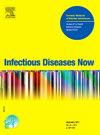Bacterial epidemiology and antibiotic resistance rates in male urinary tract infections in France, 2019–2023
IF 2.2
4区 医学
Q2 INFECTIOUS DISEASES
引用次数: 0
Abstract
Aim
The aim of this study was to describe the bacterial epidemiology and antibiotic resistance rates of bacterial isolates collected from urine specimens in male patients with suspected urinary tract infection (UTI).
Methods
This retrospective multicenter study included routine data from midstream urine cultures of adult male patients with suspected UTI admitted to the emergency departments of 15 hospitals from 2019 to 2023. Urinalysis was performed according to the recommendations of the French Society for Microbiology and bacterial identification was carried out using MALDI-TOF mass spectrometry. Antimicrobial susceptibility testing was performed by disk diffusion or semi-automated methods and interpreted according to the CA-SFM/EUCAST guidelines.
Results
Overall, 38,279 bacterial isolates were detected among 33,113 male patients (mean age = 70.7 years). The most frequently encountered pathogen was E. coli (40.0 %) followed by E. faecalis (13.2 %), K. pneumoniae (7.8 %) and P. mirabilis (5.8 %). Overall prevalence of ESBL-E was 9.0 %, represented mainly by K. pneumoniae (22.8 %), E. cloacae complex (19.3 %) and E. coli (8.4 %). Prevalence of resistance to fluoroquinolones and cotrimoxazole was high (usually > 15–20 %). The resistance rates in E. coli were very low (around 1 %) for fosfomycin and nitrofurantoin, as was the overall prevalence of carbapenemase-producing Enterobacterales (0.1 %). In S. aureus, 20.4 % of isolates were resistant to methicillin, and only three vancomycin-resistant enterococci (<0.01 %) were detected.
Conclusion
This original study provides recent, nationwide and helpful data on bacterial epidemiology and antibiotic resistance rates of isolates recovered from urines in male patients with suspected UTIs.
2019-2023年法国男性尿路感染细菌流行病学及抗生素耐药率
目的:了解疑似尿路感染(UTI)男性患者尿液标本中分离细菌的流行病学及耐药性。方法:本回顾性多中心研究纳入了2019年至2023年15家医院急诊科收治的疑似尿路感染成年男性患者的中游尿培养常规数据。根据法国微生物学会的建议进行尿液分析,并使用MALDI-TOF质谱法进行细菌鉴定。药敏试验采用纸片扩散法或半自动方法进行,并按照CA-SFM/EUCAST指南进行解释。结果:在33,113例男性患者中共检出38,279株细菌,平均年龄 = 70.7 岁。最常见的病原菌为大肠杆菌(40.0 %),其次为粪肠杆菌(13.2 %)、肺炎克雷伯菌(7.8 %)和神奇假单胞菌(5.8 %)。ESBL-E的总患病率为9.0 %,主要为肺炎克雷伯菌(22.8% %)、阴沟肠杆菌(19.3% %)和大肠杆菌(8.4 %)。氟喹诺酮类药物和复方新诺唑耐药率较高(通常为 > 15-20 %)。大肠杆菌对磷霉素和呋喃酮的耐药率非常低(约为1 %),产碳青霉烯酶肠杆菌的总体患病率也很低(0.1 %)。在金黄色葡萄球菌中,20.4 %的分离株对甲氧西林耐药,只有3株对万古霉素耐药的肠球菌(结论:这项原始研究提供了最新的、全国性的、有用的数据,用于从疑似uti的男性患者尿液中回收的细菌流行病学和抗生素耐药率。
本文章由计算机程序翻译,如有差异,请以英文原文为准。
求助全文
约1分钟内获得全文
求助全文
来源期刊

Infectious diseases now
Medicine-Infectious Diseases
CiteScore
7.10
自引率
2.90%
发文量
116
审稿时长
40 days
 求助内容:
求助内容: 应助结果提醒方式:
应助结果提醒方式:


